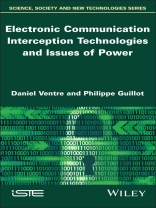In cyberspace, data flows transit massively and freely on a planetary scale. The generalization of encryption, made necessary by the need to protect these exchanges, has resulted in states and their intelligence services forgoing listening and interception missions. The latter have had to find ways to break or circumvent this protection.
This book analyzes the evolution of the means of communication and interception, as well as their implementation since the advent of the telegraph in the 19th century. It presents this sensitive subject from a technical, historical and political perspective, and answers several questions: who are the actors of interception? Who has produced the recent technologies? How are the markets for interception means organized? Are the means of protecting communications infallible? Or what forms of power do interceptions confer?
This book analyzes the evolution of the means of communication and interception, as well as their implementation since the advent of the telegraph in the 19th century. It presents this sensitive subject from a technical, historical and political perspective, and answers several questions: who are the actors of interception? Who has produced the recent technologies? How are the markets for interception means organized? Are the means of protecting communications infallible? Or what forms of power do interceptions confer?
Inhaltsverzeichnis
Introduction ixChapter 1 History and Repertoire of Communication Interception Practices 1
1.1 Military interceptions during the war 7
1.1.1 The interception of telegraphic communications 7
1.1.2 The interception of radio communications 13
1.1.3 Telephone interception 16
1.1.4 The use of SIGINT capabilities 18
1.1.5 Wartime interceptions in cyberspace 21
1.1.6 Drones and interceptions 23
1.2 The interception of international communications: espionage, surveillance, war 23
1.2.1 The interception of telegrams 23
1.2.2 Espionage during the Cold War: satellite, radio, telephone interceptions 24
1.2.3 The interception of international communications: the Echelon program 25
1.2.4 Bulk cyber surveillance 27
1.2.5 Foreign companies in national telecommunication infrastructures 28
1.2.6 Actions over undersea Internet cables 29
1.2.7 Interceptions in planes and airports 30
1.2.8 International interceptions as a product of secret alliances 30
1.3 Interception of diplomatic correspondence 31
1.4 Political surveillance: targeted and bulk interceptions 33
1.4.1 Interception of correspondence 33
1.4.2 Bulk domestic surveillance in East Germany 36
1.4.3 Cyber surveillance in Russia: the SORM system 36
1.4.4 Fixed and mobile telephone tapping 37
1.4.5 The interception of electronic communications in the political sphere 40
1.5 Criminal interceptions 42
1.6 Police, justice: the fight against crime, lawful interceptions 44
1.7 On the usefulness and effectiveness of interceptions 45
Chapter 2 The Central Issue of Encryption 55
2.1 The capabilities required for interceptions 55
2.1.1 Material, technological capabilities 56
2.1.2 Human resources 79
2.2 Protecting yourself against the threat of interceptions: encryption 87
2.2.1 The public key revolution 88
2.2.2 Advances in factorization 89
2.2.3 Shor’s quantum algorithm 91
2.2.4 The evolution of computing capabilities 93
2.2.5 The evolution of etching precision 94
2.3 Attacking encrypted communications, circumventing the hurdle of encryption 94
2.3.1 Interceptions on encrypted messaging 95
2.3.2 The attacks against keys and PKIs 104
2.3.3 The use of backdoors 108
Chapter 3 Power Struggles 131
3.1 State pressure on the industry: cooperation or coercion logics? 131
3.2 The accounts of whistleblowers and their analyses of the balance of power between the state, the citizen and companies 136
3.2.1 The account of Herbert O Yardley 136
3.2.2 The account of Perry Fellwock (also known as Winslow Peck) 137
3.2.3 The account of Mark Klein 138
3.2.4 The account of James Bamford 142
3.2.5 The account of Babak Pasdar 145
3.2.6 The account of Joseph Nacchio 146
3.2.7 The account of Edward Snowden 146
3.2.8 The account of Julian Assange 148
3.3 Limits imposed on the state’s power to control technology 149
3.3.1 The difficult and fragile international regulation of technologies 149
3.3.2 Illicit markets and the circumvention of laws 154
3.4 Trust 162
3.4.1 How much confidence in encryption? 163
3.4.2 The acceleration of calculations as a factor of confidence 164
3.4.3 Abandoning secret methods 165
3.4.4 Provable security 167
3.4.5 The worlds of Impagliazzo 169
3.4.6 The contribution of quantum computing 172
3.5 Conclusion 173
3.5.1 Technologies 173
3.5.2 Actors 174
3.5.3 Interactions or relationships 175
Appendices 179
References 201
Index 217
Über den Autor
Daniel Ventre has a Ph D in political science and is a researcher at CESDIP Laboratory (CNRS, Paris-Saclay University, France). His research focuses on cybersecurity, cybercrime and cyber defense.Philippe Guillot has a Ph D in computer science and taught cryptology and its history at the University of Paris 8, France. He is also a member of the ARCSI.
Sprache Englisch ● Format EPUB ● Seiten 256 ● ISBN 9781394236718 ● Dateigröße 3.7 MB ● Verlag John Wiley & Sons ● Erscheinungsjahr 2023 ● Ausgabe 1 ● herunterladbar 24 Monate ● Währung EUR ● ID 9151272 ● Kopierschutz Adobe DRM
erfordert DRM-fähige Lesetechnologie












